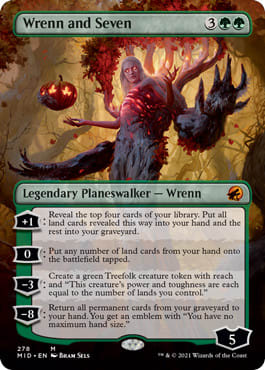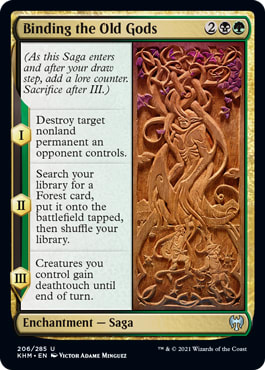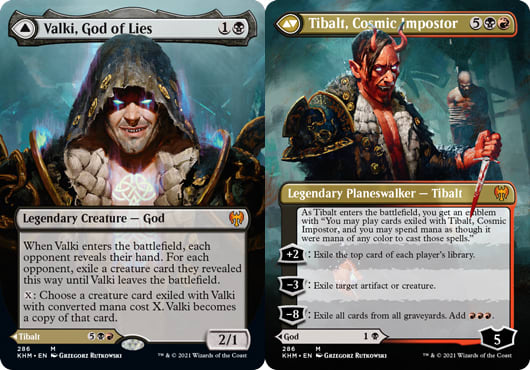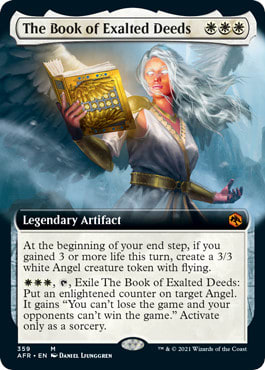Before we start, just wanted to shout out that I'm trying something new. There is an audio version of this article if you want to just download, listen, or hopefully subscribe. I don't know if I'll have the bandwidth to do every episode, but I do intend to not only revisit some of my favorites from here on CoolStuffInc, but my larger back catalog of over twenty years.
Anyway, here's the first:
Onward!
Here is the deck:
Golgari Snow | MID Standard | Michael Flores
- Creatures (17)
- 1 Valki, God of Lies
- 4 Eyetwitch
- 4 Shambling Ghast
- 4 Prosperous Innkeeper
- 4 Skullport Merchant
- Planeswalkers (7)
- 3 Wrenn and Seven
- 4 Lolth, Spider Queen
- Instants (4)
- 4 Deadly Dispute
- Sorceries (4)
- 4 Blood on the Snow
- Enchantments (4)
- 4 Binding the Old Gods
- Lands (24)
- 3 Snow-Covered Forest
- 9 Snow-Covered Swamp
- 4 Darkbore Pathway // Slitherbore Pathway
- 4 Faceless Haven
- 4 Woodland Chasm
- Sideboard (7)
- 2 Environmental Sciences
- 2 Mascot Exhibition
- 1 Necrotic Fumes
- 1 Containment Breach
- 1 Pest Summoning
Simple and straightforward, a seventy-five (or sixty-seven, increasingly, these days) does not tell the tale entirely. So please indulge me in...
Answering Your Top 8 Questions About Golgari Snow
1. So Tell Me About This Tweet That Started it All...
Actually, the story was mostly over (for me at least) at the point that I sent it.
When Innistrad: Midnight Hunt was released on Magic: The Gathering Arena last week, I initially worked from my Rakdos Dragons deck from Standard 2022.
That deck was a great performer in the previous format; essentially the best of the available Blood Money decks against Blood Money decks because of Immersturm Predator's ability to both pre-empt and out-last Blood on the Snow itself... But I found that the new set's additions changed a little something.
There was a new card joining Lolth (and Goldspan Dragon) at the five that queered the power structure at the top of the metagame:
I did not like my results against the early-popular Gruul deck at all. Wrenn and Seven completely dominated Goldspan Dragon!
This got me thinking...
I was pretty sure that Blood on the Snow was still the most powerful thing that you could be doing in Standard (or at least a close contender with Alrund's Epiphany), but the appearance of Wrenn and Seven looked like it would shift the splash color of choice from Red back to Green.
I used a couple of Mythic wild cards to obtain a few copies of Wrenn and Seven of my own and that was very nearly all she wrote:
Made Mythic on MTGArena with this today. Basically ran all the way through Diamond in less than 24 hours once I wild carded Wrenn and Seven.
— Michael Flores (@fivewithflores) September 21, 2021
Big thanks to @covertgoblue for inspiration and CC to my good buddies at @ArenaDecklists https://t.co/wfQzhFXQkg pic.twitter.com/q8NmIXe6yW
I did literally no tweaking through my initial run to Mythic. I am not sure what my incumbent rank was, but let's assume it was Platinum 1 or somewhere around Diamond 4. I lost three total matches from Diamond 4 to Diamond 1:1, which put my win rate through Diamond (minus Diamond 1:1) at well over 80%. I've never even heard of a deck with that kind of a win rate! Don't worry! I will both discuss what makes it tick and came back down to earth at Diamond 1:1.
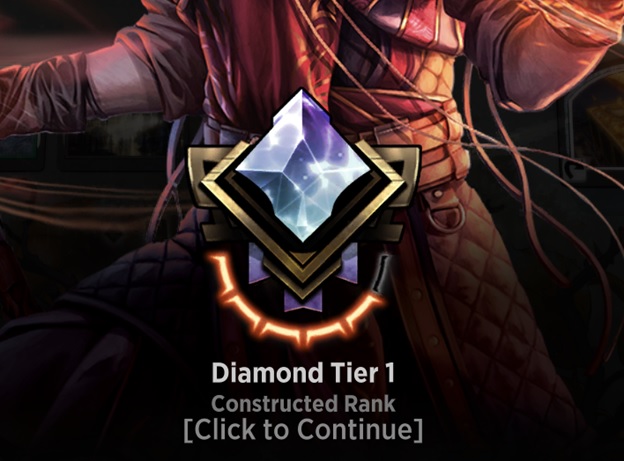
This last tick was a bear. I lost three in a row at the Mythic-or-break before getting back. Then I lost twice in a row; and I lost one last time before achieving the Mythic mantle. Meaning I lost twice as many matches at the final tick relative to all the rest of Diamond.
"LOL"
That wasn't the whole story, though. The deck got a little attention, and folks both on the Interwebs and IRL have told me how much fun and success they've had.
Woohoo, I made it the first time to Mythic as well!
— Juan Diaz (@AukiJuanDiaz) September 23, 2021
I got stuck in Diamond 3 with Rakdos Snow in S22-Format.
Michael, thanks to your deck list (with the tweak for chariot) I made it through the rest of diamond in less than a day. pic.twitter.com/6IoXL2RvYH
The nicest pat on the head, though, was my fellow CoolStuffInc content creator, CovertGoBlue dedicating a recent episode to it; where his stats machine alleges a sub-40% win rate both on the play and on the draw despite never losing a match on camera. Math, am I right? Credit where credit is due: My Golgari Snow deck borrows heavily from CGB's Blood Money videos. Highest form of flattery, here.
2. You used the word "dominate" a moment ago. Can you talk more about that?
In poker, Player A is said to dominate Player B if Player A is highly favored to win the hand (with Player B having three or fewer total outsl) but that Player B is not actually drawing dead.
For instance, AK is a very good starting hand. Let's say Player B has AK... But Player A has AA.
Luck has to go very, very well for Player B to get out of this. Normally AK is vastly improved by an ace... But in this case, Player A would have AAA (a generally titanic hand even if Player B were not dominated) to Player B's AAK. Atrociously, Player B will often find himself hemorrhaging his whole stack into a dominated position. Player B can pair Kings - the second strongest pair in poker - but will still be a third King from getting anywhere against Player A's starting Aces.
The nomenclature for Magic follows here. Goldspan Dragon is a five-mana spell. It is in fact a great five-mana spell for Standard! Heck of an AK if you know what I'm saying. But Goldspan Dragon playing into either Lolth or Wrenn and Seven will find itself far behind.
Lolth can kill the Goldspan Dragon with a block, all other things held equal, pairing a remaining Treasure token with a three-counter Lolth. Wrenn and Seven is even worse! Much of the time the Dragon won't even be able to get through the Treefolk. Even if it can trade, a tiny Wrenn and Seven is still a card advantage and mana acceleration machine unmatched in the format. No one is scared of your remaining Treasure token.
The important leap for me happened when I realized that playing a Golgari Snow deck would offer three key advantages against a format that largely assumed that Goldspan Dragon was the top overall threat.
- Lolth dominates Goldspan Dragon at five.
- Wrenn and Seven REALLY dominates Goldspan Dragon at five.
- I can get to five faster than they do, anyway.
3. What do you mean you can get to five faster? Doesn't everyone get to five at the same rate?
Actually... No.
I try to play this card on turn one as often as I can:
Sometimes I've started with Deadly Dispute. Which is great! I have a straight route to 5 mana on turn three. Even if I don't have a third land, I'll get four - four - pulls to three before I need it.
Sometimes I haven't started with Deadly Dispute but I might draw it. Even if I don't, I can block and get a treasure and hit five on four if not five on three. Which isn't the fastest, but is still faster than usual.
4. It seems to me a lot of the Blood on the Snow decks do similar things. Outside of Wrenn and Seven being the alleged best, aren't there other incentives to other color combinations?
Like I said, I thought that Rakdos was better than the other possibilities in the previous format. If you assume everybody is trying to get to the same place (just Blood on the Snow fights at six and beyond), then you might come to that conclusion.
But!
... That is not an accurate set of assumptions.
Yes, Blood on the Snow remains one of the most powerful things at the top, but if you just assume it's going to be value creatures and Planeswalkers trading with maybe a Mascot Exhibition thrown in, then it just comes down to who draws the most copies of Blood on the Snow. Winning with that kind of assumption is akin to prayer; and prayer is not a strategy.
The secret here is that every single card in this list is a two-for-one (or better).
Orzhov Snow basically slots Kaya into the secondary Planeswalker position at five. You might personally like Kaya more than Wrenn and Seven, Lolth, or even Goldspan Dragon... And I can see arguments in favor of Kaya, sure.
You get Professor of Symbology instead of Prosperous Innkeeper. Again, you might like the additional looks at your sideboard over Eyetwitch... But in a long game you're going to end up running out of useful pulls well before you hit all seven sideboard slots. Prosperous Innkeeper's acceleration is more cohesive for hitting the key mana flash point of five; and offers an ever-surprising (but even more ever-welcome) burst of two life in concert with Lolth.
Forget about either of those arguments for a second. Sure, Kaya is a good card; and sure both Professor of Symbology and Prosperous Innkeeper have potential advantages over the other.
This is the real reason Golgari is way, way better than Orzhov, heads up:
Vanishing Verse is certainly a flexible card! It's not more flexible than Binding the Old Gods, though. Binding the Old Gods helps break the big threat / Planeswalker symmetry before you have to start using Blood on the Snow. Unlike Vanishing Verse, it does so while generating card advantage.
I had really good luck against other Black control decks all through Diamond for that reason above all others. Over and over my opponents would have cards like Soul Shatter, Infernal Grasp, and Bloodchief's Thirst.
Yes, they would be able to kick Bloodchief's Thirst to kill my Wrenn and Seven... But I would still have a 5/5 or 6/6 they would have to tangle with, spend another precious removal card on, or lose to. The fact that every card I played was a two-for-one (or better) and some of their cards were one-for-one (with sometimes a downside, like Infernal Grasp or Baleful Mastery) meant that I would constantly have just a little more material to work with. I could wait longer to start answering Blood on the Snow with Blood on the Snow; and sometimes I could hold Blood on the Snow and answer the opponent's with a "mere" Binding the Old Gods.
Not for nothing, Binding the Old Gods is also the best mana acceleration card in Standard, itself often setting up Blood on the Snow in non-Black mirrors.
5. Did you just say "every"? That's not very dialectical.
You've got me!
Every 1-drop from the Treasure token on Shambling Ghast to the haymaker fives is worth more than one piece of cardboard.
... But there is one sore thumb.
This card needs a little commentary, I suppose.
First off, it is almost never right to play this card on the front side. I once made the mistake of copying my opponent's Yasharn, Implacable Earth and had to get it killed before I could turn my own Treasure engine back on. What a waste!
As Tibalt, Cosmic Impostor this card is the most powerful single thing almost anyone can do in the format... Even if it bites a relevant point removal the opponent [still] has that deep in the game, Tibalt will usually prove worth three cards... Two only when you really, really needed the first one.
This deck has no red producing lands, though; so, if you plan to play Tibalt, you'll need to save a Treasure, digging into your total material somewhat.
I can see cutting Valki, especially if you want to try the fourth main-deck Wrenn and Seven or try Esika's Chariot. But you'll lose more than the Apex Predator of this list.
I chose not to play any copies of Field of Ruin... Which might be wrong. That puts us ostensibly behind against The Book of Exalted Deeds. However, those maniacs usually play Field of Ruin of their own. We can eventually mill one of theirs and undo the combo using the Weapons of the Enemy against themselves! Cue maniacal laugh.
I do think that CovertGoBlue made an excellent point in his video. A single Field of Ruin can disincentivize multiple creature lands from activating or attacking... Plus Field is a semi-combo with our second-best threat, certainly worth consideration.
6. Surely this deck is terrible against Blue Control, though, right?
Shockingly... No.
I probably lose a little more to ![]()
![]() than I win. Part of that is just that there are lots of different
than I win. Part of that is just that there are lots of different ![]()
![]() decks and I tend to play very tentatively against them when I don't know which list I'm up against.
decks and I tend to play very tentatively against them when I don't know which list I'm up against.
For instance, the combo Alrund's Epiphany deck doesn't play that much permission, so you can go harder... But you might not know that's the build you're up against before you've given up too many turns... And not to Alrund's Epiphany.
However, I beat every single ![]()
![]() and
and ![]()
![]() Control deck I played against prior to hitting Mythic. This was indeed surprising... But ended up logical in the post-game.
Control deck I played against prior to hitting Mythic. This was indeed surprising... But ended up logical in the post-game.
While its creatures are not very Jackal Pup-ish, they are still fast. This deck deploys creatures to the battlefield from turn one, and can rack up damage against an opponent who is ignoring them surprisingly quickly. Often at the point the opponent starts caring, they're already at ten, and when they start taking defensive actions you can start deploying the big spells you've held back.
At the same time it presents competing threats (Planeswalkers and creature lands) that don't die to Doomskar or Shadow's Verdict. The important thing, though, is when you consider Lolth versus Wrenn and Seven, this is a deck that can both go wide and go tall. That's new. And big.
7. So does it beat everything then?
Gawd, no.
I said earlier that I performed great against other Blood on the Snow decks. This is true without reservation... For the most part.
I did not beat this card even one time:
My God did this card wallop me. The third and final time I got my butt handed to me by Sedgemoor Witch I was up by nine cards and saw daylight. Then they cast Plumb the Forbidden and... Needless to say I was no longer up nine cards.
The other deck (besides ![]()
![]() ) I wouldn't necessarily want to tangle with is Selesnya Ramp. I have beaten decks with over 200 life who hit multiple 80+ power copies of Trelasarra, Moon Dancer; I called up my sometimes podcast partner Roman Fusco - elated! - when I beat third turn Esika's Chariot / fourth turn Esika's Chariot / fifth turn Esika's Chariot AND double Storm the Festival... But I've lost pedestrian games where I fell behind a Scute Swarm and didn't draw Blood on the Snow, too.
) I wouldn't necessarily want to tangle with is Selesnya Ramp. I have beaten decks with over 200 life who hit multiple 80+ power copies of Trelasarra, Moon Dancer; I called up my sometimes podcast partner Roman Fusco - elated! - when I beat third turn Esika's Chariot / fourth turn Esika's Chariot / fifth turn Esika's Chariot AND double Storm the Festival... But I've lost pedestrian games where I fell behind a Scute Swarm and didn't draw Blood on the Snow, too.
8. So what's next? How do you improve this deck?
I've tried other decks and other builds since hitting Mythic.
After so many folks hitting Mythic with Esika's Chariot inclusions I had to try it, myself. There is little more exciting in Standard than pairing up the token-copying ability on Esika's Chariot with the colossal minus ability on Wrenn and Seven! But adding that card hasn't actually added to my win percentage.
If there is anything I would consider changing it would be to add The Meathook Massacre. The Meathook Massacre - in this deck, at least - is like adding additional Blood on the Snow-type sweeping; plus, it provides a little grinding power. The easiest shave is obviously the singleton Tibalt; but I do think you'd need to swap out 1-2 lands for Field of Ruin in that case. A second The Meathook Massacre might come in for the last Lolth... But I do hate losing that measure of Goldspan Dragon domination.
Anyway, this deck was great for me. Grinding to Mythic this month felt almost effortless, and best of all, it was a treat to see many others making Mythic themselves - including their own first forays to the rank - with similar inspired strategies.
LOVE
MIKE
















